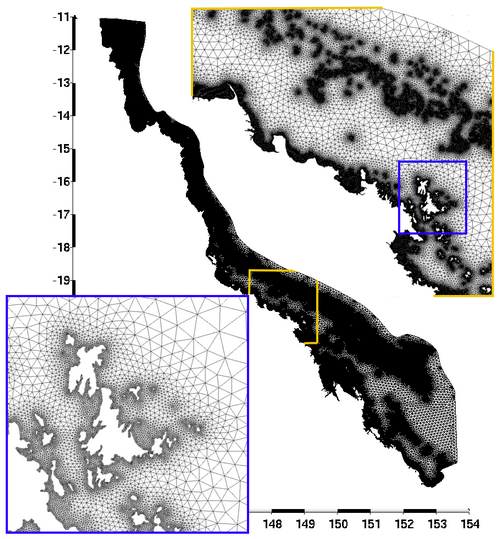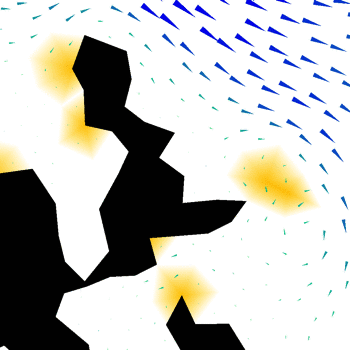High quality meshes adjusted to the simulations’ needs are essential to take advantage of the finite element method. That’s why the mesh generation tool constitutes a crucial part of this model. SLIM relies on the state-of-the-art mesh-generation software GMSH to build meshes whose resolution can depend on a number of different criteria such as:
the distance from coastlines,
the square root of the bathymetry,
the curvature of the bathymetry,
the curvature of the coastlines,
the location of a specific region of interest,
the error measured from a previous simulation.
These different criteria are blended together to create a unique mesh resolution map.
The quality of the simulation strongly depends on the quality of the mesh. By locally increasing the mesh resolution, we can capture small-scale flow features and accurately describe the topography. The animation below shows the impact of the mesh resolution on the representation of the topography, which in turn influences the flow. The coarsest mesh has a 4km resolution that cannot represent all the small islands present in that area. As a result, they are all merged together in a continuous piece of land. By increasing the resolution to 2km, 1km, 500m and finally 250m, we can see how small-scale topographic features start to appear in the mesh and how they influence the flow. In particular, recirculation eddies are only present with a resolution of at least 500m.
To learn more…
778265
mesh
1
apa
50
date
desc
6773
https://www.slim-ocean.be/wp-content/plugins/zotpress/
%7B%22status%22%3A%22success%22%2C%22updateneeded%22%3Afalse%2C%22instance%22%3Afalse%2C%22meta%22%3A%7B%22request_last%22%3A0%2C%22request_next%22%3A0%2C%22used_cache%22%3Atrue%7D%2C%22data%22%3A%5B%7B%22key%22%3A%22Z73QS8B5%22%2C%22library%22%3A%7B%22id%22%3A778265%7D%2C%22meta%22%3A%7B%22creatorSummary%22%3A%22Saint-Amand%20et%20al.%22%2C%22parsedDate%22%3A%222023-06-09%22%2C%22numChildren%22%3A1%7D%2C%22bib%22%3A%22%26lt%3Bdiv%20class%3D%26quot%3Bcsl-bib-body%26quot%3B%20style%3D%26quot%3Bline-height%3A%202%3B%20padding-left%3A%201em%3B%20text-indent%3A-1em%3B%26quot%3B%26gt%3B%5Cn%20%20%26lt%3Bdiv%20class%3D%26quot%3Bcsl-entry%26quot%3B%26gt%3BSaint-Amand%2C%20A.%2C%20Lambrechts%2C%20J.%2C%20%26amp%3B%20Hanert%2C%20E.%20%282023%29.%20Biophysical%20models%20resolution%20affects%20coral%20connectivity%20estimates.%20%26lt%3Bi%26gt%3BScientific%20Reports%26lt%3B%5C%2Fi%26gt%3B%2C%20%26lt%3Bi%26gt%3B13%26lt%3B%5C%2Fi%26gt%3B%281%29%2C%209414.%20%26lt%3Ba%20class%3D%26%23039%3Bzp-DOIURL%26%23039%3B%20href%3D%26%23039%3Bhttps%3A%5C%2F%5C%2Fdoi.org%5C%2F10.1038%5C%2Fs41598-023-36158-5%26%23039%3B%26gt%3Bhttps%3A%5C%2F%5C%2Fdoi.org%5C%2F10.1038%5C%2Fs41598-023-36158-5%26lt%3B%5C%2Fa%26gt%3B%26lt%3B%5C%2Fdiv%26gt%3B%5Cn%26lt%3B%5C%2Fdiv%26gt%3B%22%2C%22data%22%3A%7B%22itemType%22%3A%22journalArticle%22%2C%22title%22%3A%22Biophysical%20models%20resolution%20affects%20coral%20connectivity%20estimates%22%2C%22creators%22%3A%5B%7B%22creatorType%22%3A%22author%22%2C%22firstName%22%3A%22Antoine%22%2C%22lastName%22%3A%22Saint-Amand%22%7D%2C%7B%22creatorType%22%3A%22author%22%2C%22firstName%22%3A%22Jonathan%22%2C%22lastName%22%3A%22Lambrechts%22%7D%2C%7B%22creatorType%22%3A%22author%22%2C%22firstName%22%3A%22Emmanuel%22%2C%22lastName%22%3A%22Hanert%22%7D%5D%2C%22abstractNote%22%3A%22Abstract%5Cn%20%20%20%20%20%20%20%20%20%20%20%20Estimating%20connectivity%20between%20coral%20reefs%20is%20essential%20to%20inform%20reef%20conservation%20and%20restoration.%20Given%20the%20vastness%20of%20coral%20reef%20ecosystems%2C%20connectivity%20can%20only%20be%20simulated%20with%20biophysical%20models%20whose%20spatial%20resolution%20is%20often%20coarser%20than%20the%20reef%20scale.%20Here%2C%20we%20assess%20the%20impact%20of%20biophysical%20models%20resolution%20on%20connectivity%20estimates%20by%20comparing%20the%20outputs%20of%20five%20different%20setups%20of%20the%20same%20model%20with%20resolutions%20ranging%20from%20250%5Cu00a0m%20to%204%5Cu00a0km.%20We%20show%20that%20increasing%20the%20model%20resolution%20around%20reefs%20yields%20more%20complex%20and%20less%20directional%20dispersal%20patterns.%20With%20a%20fine-resolution%20model%2C%20connectivity%20graphs%20have%20more%20connections%20but%20of%20weaker%20strength.%20The%20resulting%20community%20structure%20therefore%20shows%20larger%20clusters%20of%20well-connected%20reefs.%20Virtual%20larvae%20also%20tend%20to%20stay%20longer%20close%20to%20their%20source%20reef%20with%20a%20fine-resolution%20model%2C%20leading%20to%20an%20increased%20local%20retention%20and%20self-recruitment%20for%20species%20with%20a%20short%20pre-competency%20period.%20Overall%2C%20only%20about%20half%20of%20the%20reefs%20with%20the%20largest%20connectivity%20indicator%20values%20are%20similar%20for%20the%20finest%20and%20coarsest%20resolution%20models.%20Our%20results%20suggest%20that%20reef%20management%20recommendations%20should%20only%20be%20made%20at%20scales%20coarser%20than%20the%20model%20resolution.%20Reef-scale%20recommendations%20can%20hence%20only%20be%20made%20with%20models%20not%20exceeding%20about%20500%5Cu00a0m%20resolution.%22%2C%22date%22%3A%222023-06-09%22%2C%22language%22%3A%22en%22%2C%22DOI%22%3A%2210.1038%5C%2Fs41598-023-36158-5%22%2C%22ISSN%22%3A%222045-2322%22%2C%22url%22%3A%22https%3A%5C%2F%5C%2Fwww.nature.com%5C%2Farticles%5C%2Fs41598-023-36158-5%22%2C%22collections%22%3A%5B%22GJSQZPDC%22%5D%2C%22dateModified%22%3A%222023-06-14T06%3A42%3A46Z%22%7D%7D%2C%7B%22key%22%3A%22KJRUBWX9%22%2C%22library%22%3A%7B%22id%22%3A778265%7D%2C%22meta%22%3A%7B%22creatorSummary%22%3A%22Saint-Amand%20et%20al.%22%2C%22parsedDate%22%3A%222023%22%2C%22numChildren%22%3A1%7D%2C%22bib%22%3A%22%26lt%3Bdiv%20class%3D%26quot%3Bcsl-bib-body%26quot%3B%20style%3D%26quot%3Bline-height%3A%202%3B%20padding-left%3A%201em%3B%20text-indent%3A-1em%3B%26quot%3B%26gt%3B%5Cn%20%20%26lt%3Bdiv%20class%3D%26quot%3Bcsl-entry%26quot%3B%26gt%3BSaint-Amand%2C%20A.%2C%20Lambrechts%2C%20J.%2C%20Thomas%2C%20C.%20J.%2C%20%26amp%3B%20Hanert%2C%20E.%20%282023%29.%20How%20fine%20is%20fine%20enough%3F%20Effect%20of%20mesh%20resolution%20on%20hydrodynamic%20simulations%20in%20coral%20reef%20environments.%20%26lt%3Bi%26gt%3BOcean%20Modelling%26lt%3B%5C%2Fi%26gt%3B%2C%20%26lt%3Bi%26gt%3B186%26lt%3B%5C%2Fi%26gt%3B%2C%20102254.%20%26lt%3Ba%20class%3D%26%23039%3Bzp-DOIURL%26%23039%3B%20href%3D%26%23039%3Bhttps%3A%5C%2F%5C%2Fdoi.org%5C%2F10.1016%5C%2Fj.ocemod.2023.102254%26%23039%3B%26gt%3Bhttps%3A%5C%2F%5C%2Fdoi.org%5C%2F10.1016%5C%2Fj.ocemod.2023.102254%26lt%3B%5C%2Fa%26gt%3B%26lt%3B%5C%2Fdiv%26gt%3B%5Cn%26lt%3B%5C%2Fdiv%26gt%3B%22%2C%22data%22%3A%7B%22itemType%22%3A%22journalArticle%22%2C%22title%22%3A%22How%20fine%20is%20fine%20enough%3F%20Effect%20of%20mesh%20resolution%20on%20hydrodynamic%20simulations%20in%20coral%20reef%20environments%22%2C%22creators%22%3A%5B%7B%22creatorType%22%3A%22author%22%2C%22firstName%22%3A%22Antoine%22%2C%22lastName%22%3A%22Saint-Amand%22%7D%2C%7B%22creatorType%22%3A%22author%22%2C%22firstName%22%3A%22Jonathan%22%2C%22lastName%22%3A%22Lambrechts%22%7D%2C%7B%22creatorType%22%3A%22author%22%2C%22firstName%22%3A%22Christopher%20J.%22%2C%22lastName%22%3A%22Thomas%22%7D%2C%7B%22creatorType%22%3A%22author%22%2C%22firstName%22%3A%22Emmanuel%22%2C%22lastName%22%3A%22Hanert%22%7D%5D%2C%22abstractNote%22%3A%22Coral%20reef%20environments%20are%20biodiversity%20hotspots%20that%20provide%20many%20services%20to%20coastal%20communities.%20They%20are%20currently%20facing%20an%20increasing%20anthropogenic%20pressure%20that%20jeopardises%20their%20survival.%20Numerical%20ocean%20models%20are%20an%20important%20tool%20to%20understand%20the%20functioning%20of%20coral%20ecosystems%20and%20the%20mechanisms%20ensuring%20their%20resilience.%20However%2C%20simulating%20the%20water%20circulation%20through%20reef%20systems%20is%20challenging%20because%20of%20their%20naturally%20complex%20topography%20and%20bathymetry.%20Many%20ocean%20models%20used%20for%20such%20applications%20have%20a%20spatial%20resolution%20coarser%20than%20the%20scale%20of%20individual%20reefs%2C%20which%20puts%20into%20question%20their%20suitability%20for%20the%20task.%20Here%2C%20we%20assess%20the%20sensitivity%20of%20a%20coastal%20ocean%20model%5Cu2019s%20outputs%20to%20its%20spatial%20resolution%20when%20simulating%20the%20water%20circulation%20in%20the%20entire%20Great%20Barrier%20Reef%20%28Australia%29%2C%20the%20largest%20coral%20reef%20system%20in%20the%20world.%20We%20consider%20the%20same%20model%20with%20five%20different%20resolutions%20near%20reefs%2C%20ranging%20from%20250%20m%20to%204%20km%2C%20and%20compare%20the%20model%20outputs%20at%20different%20locations%20around%20reefs%20and%20in%20the%20open%20ocean.%20We%20also%20simulate%20the%20transport%20of%20passive%20particles%20released%20from%20those%20different%20locations.%20Our%20results%20show%20that%20the%20simulated%20tidal%20signal%20is%20similar%20for%20all%20five%20resolutions.%20However%2C%20strong%20discrepancies%20%28%26gt%3B%2010%20cm%5C%2Fs%29%20in%20the%20current%20velocity%20are%20observed%20near%20the%20reefs%20and%20along%20the%20rugged%20coastline.%20When%20using%20a%20coarse-resolution%20model%2C%20the%20amplitude%20of%20the%20currents%20is%20overestimated%20over%20reefs%2C%20and%20underestimated%20between%20them.%20We%20find%20that%20validating%20the%20model%20at%20deep%20water%20mooring%20sites%20is%20not%20sufficient%20to%20ensure%20it%20performs%20well%20close%20to%20reefs.%20Discrepancies%20in%20currents%20lead%20to%20more%20directional%20and%20uniform%20tracer%20dispersal%20patterns%20on%20coarse-resolution%20meshes%20that%20contrast%20with%20the%20more%20dispersive%20patterns%20observed%20on%20fine-resolution%20meshes.%20Those%20differences%20at%20the%20reef%20level%20have%20a%20large%20cumulative%20effect%20when%20simulating%20transport%20processes%20over%20several%20weeks.%20Our%20results%20suggest%20that%20ocean%20circulation%20and%20transport%20simulations%20in%20coral%20reef%20environments%20should%20be%20based%20on%20model%20resolutions%20finer%20than%20the%20reef%20scale%2C%20which%20generally%20means%20a%20maximum%20resolution%20of%20about%20250%5Cu2013500%20m.%22%2C%22date%22%3A%2212%5C%2F2023%22%2C%22language%22%3A%22en%22%2C%22DOI%22%3A%2210.1016%5C%2Fj.ocemod.2023.102254%22%2C%22ISSN%22%3A%2214635003%22%2C%22url%22%3A%22https%3A%5C%2F%5C%2Flinkinghub.elsevier.com%5C%2Fretrieve%5C%2Fpii%5C%2FS1463500323000951%22%2C%22collections%22%3A%5B%22GJSQZPDC%22%5D%2C%22dateModified%22%3A%222023-09-07T11%3A09%3A50Z%22%7D%7D%2C%7B%22key%22%3A%223Z47XHKS%22%2C%22library%22%3A%7B%22id%22%3A778265%7D%2C%22meta%22%3A%7B%22creatorSummary%22%3A%22Remacle%20and%20Lambrechts%22%2C%22parsedDate%22%3A%222018%22%2C%22numChildren%22%3A1%7D%2C%22bib%22%3A%22%26lt%3Bdiv%20class%3D%26quot%3Bcsl-bib-body%26quot%3B%20style%3D%26quot%3Bline-height%3A%202%3B%20padding-left%3A%201em%3B%20text-indent%3A-1em%3B%26quot%3B%26gt%3B%5Cn%20%20%26lt%3Bdiv%20class%3D%26quot%3Bcsl-entry%26quot%3B%26gt%3BRemacle%2C%20J.-F.%2C%20%26amp%3B%20Lambrechts%2C%20J.%20%282018%29.%20Fast%20and%20robust%20mesh%20generation%20on%20the%20sphere%26%23x2014%3BApplication%20to%20coastal%20domains.%20%26lt%3Bi%26gt%3BComputer-Aided%20Design%26lt%3B%5C%2Fi%26gt%3B%2C%20%26lt%3Bi%26gt%3B103%26lt%3B%5C%2Fi%26gt%3B%2C%2014%26%23x2013%3B23.%20%26lt%3Ba%20class%3D%26%23039%3Bzp-DOIURL%26%23039%3B%20href%3D%26%23039%3Bhttps%3A%5C%2F%5C%2Fdoi.org%5C%2F10.1016%5C%2Fj.cad.2018.03.002%26%23039%3B%26gt%3Bhttps%3A%5C%2F%5C%2Fdoi.org%5C%2F10.1016%5C%2Fj.cad.2018.03.002%26lt%3B%5C%2Fa%26gt%3B%26lt%3B%5C%2Fdiv%26gt%3B%5Cn%26lt%3B%5C%2Fdiv%26gt%3B%22%2C%22data%22%3A%7B%22itemType%22%3A%22journalArticle%22%2C%22title%22%3A%22Fast%20and%20robust%20mesh%20generation%20on%20the%20sphere%5Cu2014Application%20to%20coastal%20domains%22%2C%22creators%22%3A%5B%7B%22creatorType%22%3A%22author%22%2C%22firstName%22%3A%22Jean-Fran%5Cu00e7ois%22%2C%22lastName%22%3A%22Remacle%22%7D%2C%7B%22creatorType%22%3A%22author%22%2C%22firstName%22%3A%22Jonathan%22%2C%22lastName%22%3A%22Lambrechts%22%7D%5D%2C%22abstractNote%22%3A%22This%20paper%20presents%20a%20fast%20and%20robust%20mesh%20generation%20procedure%20that%20is%20able%20to%20generate%20meshes%20of%20the%20earth%20system%20%28ocean%20and%20continent%29%20in%20matters%20of%20seconds.%20Our%20algorithm%20takes%20as%20input%20a%20standard%20shape-file%20i.e.%20geospatial%20vector%20data%20format%20for%20geographic%20information%20system%20%28GIS%29%20software.%20The%20input%20is%20initially%20coarsened%20in%20order%20to%20automatically%20remove%20unwanted%20channels%20that%20are%20under%20a%20desired%20resolution.%20A%20valid%20non-overlapping%201D%20mesh%20is%20then%20created%20on%20the%20sphere%20using%20the%20Euclidean%20coordinates%20system%20x%2C%20y%2C%20z.%20A%20modified%20Delaunay%20kernel%20is%20then%20proposed%20that%20enables%20generation%20of%20meshes%20on%20the%20sphere%20in%20a%20straightforward%20manner%20without%20parametrization.%20One%20of%20the%20main%20difficulty%20in%20dealing%20with%20geographical%20data%20is%20the%20over-sampled%20nature%20of%20coastline%20representations.%20We%20propose%20here%20an%20algorithm%20that%20automatically%20unrefines%20coastline%20data.%20Small%20features%20are%20automatically%20removed%20while%20always%20keeping%20a%20valid%20%28non-overlapping%29%20geometrical%20representation%20of%20the%20domain.%20A%20Delaunay%20refinement%20procedure%20is%20subsequently%20applied%20to%20the%20domain.%20The%20refinement%20scheme%20is%20also%20multi-threaded%20at%20a%20fine%20grain%20level%2C%20allowing%20to%20generate%20about%20a%20million%20points%20per%20second%20on%208%20threads.%20Examples%20of%20meshes%20of%20the%20Baltic%20sea%20as%20well%20as%20of%20the%20global%20ocean%20are%20presented.%22%2C%22date%22%3A%2210%5C%2F2018%22%2C%22language%22%3A%22en%22%2C%22DOI%22%3A%2210.1016%5C%2Fj.cad.2018.03.002%22%2C%22ISSN%22%3A%2200104485%22%2C%22url%22%3A%22https%3A%5C%2F%5C%2Flinkinghub.elsevier.com%5C%2Fretrieve%5C%2Fpii%5C%2FS0010448518301039%22%2C%22collections%22%3A%5B%22GJSQZPDC%22%5D%2C%22dateModified%22%3A%222019-09-22T07%3A43%3A33Z%22%7D%7D%2C%7B%22key%22%3A%226J769G26%22%2C%22library%22%3A%7B%22id%22%3A778265%7D%2C%22meta%22%3A%7B%22creatorSummary%22%3A%22Lambrechts%20et%20al.%22%2C%22parsedDate%22%3A%222008%22%2C%22numChildren%22%3A2%7D%2C%22bib%22%3A%22%26lt%3Bdiv%20class%3D%26quot%3Bcsl-bib-body%26quot%3B%20style%3D%26quot%3Bline-height%3A%202%3B%20padding-left%3A%201em%3B%20text-indent%3A-1em%3B%26quot%3B%26gt%3B%5Cn%20%20%26lt%3Bdiv%20class%3D%26quot%3Bcsl-entry%26quot%3B%26gt%3BLambrechts%2C%20J.%2C%20Comblen%2C%20R.%2C%20Legat%2C%20V.%2C%20Geuzaine%2C%20C.%2C%20%26amp%3B%20Remacle%2C%20J.-F.%20%282008%29.%20Multiscale%20mesh%20generation%20on%20the%20sphere.%20%26lt%3Bi%26gt%3BOcean%20Dynamics%26lt%3B%5C%2Fi%26gt%3B%2C%20%26lt%3Bi%26gt%3B58%26lt%3B%5C%2Fi%26gt%3B%285%26%23x2013%3B6%29%2C%20461%26%23x2013%3B473.%20%26lt%3Ba%20class%3D%26%23039%3Bzp-DOIURL%26%23039%3B%20href%3D%26%23039%3Bhttps%3A%5C%2F%5C%2Fdoi.org%5C%2F10.1007%5C%2Fs10236-008-0148-3%26%23039%3B%26gt%3Bhttps%3A%5C%2F%5C%2Fdoi.org%5C%2F10.1007%5C%2Fs10236-008-0148-3%26lt%3B%5C%2Fa%26gt%3B%26lt%3B%5C%2Fdiv%26gt%3B%5Cn%26lt%3B%5C%2Fdiv%26gt%3B%22%2C%22data%22%3A%7B%22itemType%22%3A%22journalArticle%22%2C%22title%22%3A%22Multiscale%20mesh%20generation%20on%20the%20sphere%22%2C%22creators%22%3A%5B%7B%22creatorType%22%3A%22author%22%2C%22firstName%22%3A%22Jonathan%22%2C%22lastName%22%3A%22Lambrechts%22%7D%2C%7B%22creatorType%22%3A%22author%22%2C%22firstName%22%3A%22Richard%22%2C%22lastName%22%3A%22Comblen%22%7D%2C%7B%22creatorType%22%3A%22author%22%2C%22firstName%22%3A%22Vincent%22%2C%22lastName%22%3A%22Legat%22%7D%2C%7B%22creatorType%22%3A%22author%22%2C%22firstName%22%3A%22Christophe%22%2C%22lastName%22%3A%22Geuzaine%22%7D%2C%7B%22creatorType%22%3A%22author%22%2C%22firstName%22%3A%22Jean-Fran%5Cu00e7ois%22%2C%22lastName%22%3A%22Remacle%22%7D%5D%2C%22abstractNote%22%3A%22A%20method%20for%20generating%20computational%20meshes%20for%20applications%20in%20ocean%20modeling%20is%20presented.%20The%20method%20uses%20a%20standard%20engineering%20approach%20for%20describing%20the%20geometry%20of%20the%20domain%20that%20requires%20meshing.%20The%20underlying%20sphere%20is%20parametrized%20using%20stereographic%20coordinates.%20Then%2C%20coastlines%20are%20described%20with%20cubic%20splines%20drawn%20in%20the%20stereographic%20parametric%20space.%20The%20mesh%20generation%20algorithm%20builds%20the%20mesh%20in%20the%20parametric%20plane%20using%20available%20techniques.%20The%20method%20enables%20to%20import%20coastlines%20from%20different%20data%20sets%20and%2C%20consequently%2C%20to%20build%20meshes%20of%20domains%20with%20highly%20variable%20length%20scales.%20The%20results%20include%20meshes%20together%20with%20numerical%20simulations%20of%20various%20kinds.%22%2C%22date%22%3A%2212%5C%2F2008%22%2C%22language%22%3A%22en%22%2C%22DOI%22%3A%2210.1007%5C%2Fs10236-008-0148-3%22%2C%22ISSN%22%3A%221616-7341%2C%201616-7228%22%2C%22url%22%3A%22http%3A%5C%2F%5C%2Flink.springer.com%5C%2F10.1007%5C%2Fs10236-008-0148-3%22%2C%22collections%22%3A%5B%22GJSQZPDC%22%5D%2C%22dateModified%22%3A%222018-10-21T09%3A10%3A40Z%22%7D%7D%2C%7B%22key%22%3A%22JEISL7RQ%22%2C%22library%22%3A%7B%22id%22%3A778265%7D%2C%22meta%22%3A%7B%22creatorSummary%22%3A%22Legrand%20et%20al.%22%2C%22parsedDate%22%3A%222007%22%2C%22numChildren%22%3A2%7D%2C%22bib%22%3A%22%26lt%3Bdiv%20class%3D%26quot%3Bcsl-bib-body%26quot%3B%20style%3D%26quot%3Bline-height%3A%202%3B%20padding-left%3A%201em%3B%20text-indent%3A-1em%3B%26quot%3B%26gt%3B%5Cn%20%20%26lt%3Bdiv%20class%3D%26quot%3Bcsl-entry%26quot%3B%26gt%3BLegrand%2C%20S.%2C%20Deleersnijder%2C%20E.%2C%20Delhez%2C%20E.%2C%20%26amp%3B%20Legat%2C%20V.%20%282007%29.%20Unstructured%2C%20anisotropic%20mesh%20generation%20for%20the%20Northwestern%20European%20continental%20shelf%2C%20the%20continental%20slope%20and%20the%20neighbouring%20ocean.%20%26lt%3Bi%26gt%3BContinental%20Shelf%20Research%26lt%3B%5C%2Fi%26gt%3B%2C%20%26lt%3Bi%26gt%3B27%26lt%3B%5C%2Fi%26gt%3B%289%29%2C%201344%26%23x2013%3B1356.%20%26lt%3Ba%20class%3D%26%23039%3Bzp-DOIURL%26%23039%3B%20href%3D%26%23039%3Bhttps%3A%5C%2F%5C%2Fdoi.org%5C%2F10.1016%5C%2Fj.csr.2007.01.009%26%23039%3B%26gt%3Bhttps%3A%5C%2F%5C%2Fdoi.org%5C%2F10.1016%5C%2Fj.csr.2007.01.009%26lt%3B%5C%2Fa%26gt%3B%26lt%3B%5C%2Fdiv%26gt%3B%5Cn%26lt%3B%5C%2Fdiv%26gt%3B%22%2C%22data%22%3A%7B%22itemType%22%3A%22journalArticle%22%2C%22title%22%3A%22Unstructured%2C%20anisotropic%20mesh%20generation%20for%20the%20Northwestern%20European%20continental%20shelf%2C%20the%20continental%20slope%20and%20the%20neighbouring%20ocean%22%2C%22creators%22%3A%5B%7B%22creatorType%22%3A%22author%22%2C%22firstName%22%3A%22S%5Cu00e9bastien%22%2C%22lastName%22%3A%22Legrand%22%7D%2C%7B%22creatorType%22%3A%22author%22%2C%22firstName%22%3A%22Eric%22%2C%22lastName%22%3A%22Deleersnijder%22%7D%2C%7B%22creatorType%22%3A%22author%22%2C%22firstName%22%3A%22Eric%22%2C%22lastName%22%3A%22Delhez%22%7D%2C%7B%22creatorType%22%3A%22author%22%2C%22firstName%22%3A%22Vincent%22%2C%22lastName%22%3A%22Legat%22%7D%5D%2C%22abstractNote%22%3A%22A%20new%20mesh%20re%5Cufb01nement%20strategy%20for%20generating%20high%20quality%20unstructured%20meshes%20of%20the%20Northwestern%20European%20continental%20shelf%2C%20the%20continental%20slope%20and%20the%20neighbouring%20ocean%20is%20presented.%20Our%20objective%20is%20to%20demonstrate%20the%20ability%20of%20anisotropic%20unstructured%20meshes%20to%20adequately%20address%20the%20challenge%20of%20simulating%20the%20hydrodynamics%20occurring%20in%20these%20three%20regions%20within%20a%20unique%20mesh.%20The%20re%5Cufb01nement%20criteria%20blend%20several%20hydrodynamic%20considerations%20as%20the%20tidal%20wave%20propagation%20on%20the%20continental%20shelf%20and%20the%20hydrostatic%20consistency%20condition%20in%20steep%20areas.%20Several%20meshes%20illustrate%20both%20the%20validity%20and%20the%20ef%5Cufb01ciency%20of%20the%20re%5Cufb01nement%20strategy.%20The%20selection%20of%20the%20re%5Cufb01nement%20parameters%20is%20discussed.%20Finally%2C%20an%20attempt%20is%20made%20to%20take%20into%20account%20tidal%20ellipses%2C%20providing%20another%20cause%20for%20anisotropy%20in%20the%20mesh.%22%2C%22date%22%3A%225%5C%2F2007%22%2C%22language%22%3A%22en%22%2C%22DOI%22%3A%2210.1016%5C%2Fj.csr.2007.01.009%22%2C%22ISSN%22%3A%2202784343%22%2C%22url%22%3A%22http%3A%5C%2F%5C%2Flinkinghub.elsevier.com%5C%2Fretrieve%5C%2Fpii%5C%2FS0278434307000386%22%2C%22collections%22%3A%5B%22GJSQZPDC%22%5D%2C%22dateModified%22%3A%222018-10-21T09%3A11%3A05Z%22%7D%7D%2C%7B%22key%22%3A%222P2HRD2G%22%2C%22library%22%3A%7B%22id%22%3A778265%7D%2C%22meta%22%3A%7B%22creatorSummary%22%3A%22Legrand%20et%20al.%22%2C%22parsedDate%22%3A%222006%22%2C%22numChildren%22%3A2%7D%2C%22bib%22%3A%22%26lt%3Bdiv%20class%3D%26quot%3Bcsl-bib-body%26quot%3B%20style%3D%26quot%3Bline-height%3A%202%3B%20padding-left%3A%201em%3B%20text-indent%3A-1em%3B%26quot%3B%26gt%3B%5Cn%20%20%26lt%3Bdiv%20class%3D%26quot%3Bcsl-entry%26quot%3B%26gt%3BLegrand%2C%20S.%2C%20Deleersnijder%2C%20E.%2C%20Hanert%2C%20E.%2C%20Legat%2C%20V.%2C%20%26amp%3B%20Wolanski%2C%20E.%20%282006%29.%20High-resolution%2C%20unstructured%20meshes%20for%20hydrodynamic%20models%20of%20the%20Great%20Barrier%20Reef%2C%20Australia.%20%26lt%3Bi%26gt%3BEstuarine%2C%20Coastal%20and%20Shelf%20Science%26lt%3B%5C%2Fi%26gt%3B%2C%20%26lt%3Bi%26gt%3B68%26lt%3B%5C%2Fi%26gt%3B%281%26%23x2013%3B2%29%2C%2036%26%23x2013%3B46.%20%26lt%3Ba%20class%3D%26%23039%3Bzp-DOIURL%26%23039%3B%20href%3D%26%23039%3Bhttps%3A%5C%2F%5C%2Fdoi.org%5C%2F10.1016%5C%2Fj.ecss.2005.08.017%26%23039%3B%26gt%3Bhttps%3A%5C%2F%5C%2Fdoi.org%5C%2F10.1016%5C%2Fj.ecss.2005.08.017%26lt%3B%5C%2Fa%26gt%3B%26lt%3B%5C%2Fdiv%26gt%3B%5Cn%26lt%3B%5C%2Fdiv%26gt%3B%22%2C%22data%22%3A%7B%22itemType%22%3A%22journalArticle%22%2C%22title%22%3A%22High-resolution%2C%20unstructured%20meshes%20for%20hydrodynamic%20models%20of%20the%20Great%20Barrier%20Reef%2C%20Australia%22%2C%22creators%22%3A%5B%7B%22creatorType%22%3A%22author%22%2C%22firstName%22%3A%22S%5Cu00e9bastien%22%2C%22lastName%22%3A%22Legrand%22%7D%2C%7B%22creatorType%22%3A%22author%22%2C%22firstName%22%3A%22Eric%22%2C%22lastName%22%3A%22Deleersnijder%22%7D%2C%7B%22creatorType%22%3A%22author%22%2C%22firstName%22%3A%22Emmanuel%22%2C%22lastName%22%3A%22Hanert%22%7D%2C%7B%22creatorType%22%3A%22author%22%2C%22firstName%22%3A%22Vincent%22%2C%22lastName%22%3A%22Legat%22%7D%2C%7B%22creatorType%22%3A%22author%22%2C%22firstName%22%3A%22Eric%22%2C%22lastName%22%3A%22Wolanski%22%7D%5D%2C%22abstractNote%22%3A%22Accuracy%20and%20mesh%20generation%20are%20key%20issues%20for%20the%20high-resolution%20hydrodynamic%20modelling%20of%20the%20whole%20Great%20Barrier%20Reef.%20Our%20objective%20is%20to%20generate%20suitable%20unstructured%20grids%20that%20can%20resolve%20topological%20and%20dynamical%20features%20like%20tidal%20jets%20and%20recirculation%20eddies%20in%20the%20wake%20of%20islands.%20A%20new%20strategy%20is%20suggested%20to%20re%5Cufb01ne%20the%20mesh%20in%20areas%20of%20interest%20taking%20into%20account%20the%20bathymetric%20%5Cufb01eld%20and%20an%20approximated%20distance%20to%20islands%20and%20reefs.%20Such%20a%20distance%20is%20obtained%20by%20solving%20an%20elliptic%20differential%20operator%2C%20with%20speci%5Cufb01c%20boundary%20conditions.%20Meshes%20produced%20illustrate%20both%20the%20validity%20and%20the%20ef%5Cufb01ciency%20of%20the%20adaptive%20strategy.%20Selection%20of%20re%5Cufb01nement%20and%20geometrical%20parameters%20is%20discussed.%22%2C%22date%22%3A%226%5C%2F2006%22%2C%22language%22%3A%22en%22%2C%22DOI%22%3A%2210.1016%5C%2Fj.ecss.2005.08.017%22%2C%22ISSN%22%3A%2202727714%22%2C%22url%22%3A%22http%3A%5C%2F%5C%2Flinkinghub.elsevier.com%5C%2Fretrieve%5C%2Fpii%5C%2FS0272771406000400%22%2C%22collections%22%3A%5B%22GJSQZPDC%22%5D%2C%22dateModified%22%3A%222018-10-21T09%3A11%3A16Z%22%7D%7D%2C%7B%22key%22%3A%22IKRBSF23%22%2C%22library%22%3A%7B%22id%22%3A778265%7D%2C%22meta%22%3A%7B%22lastModifiedByUser%22%3A%7B%22id%22%3A5103066%2C%22username%22%3A%22ehanert%22%2C%22name%22%3A%22%22%2C%22links%22%3A%7B%22alternate%22%3A%7B%22href%22%3A%22https%3A%5C%2F%5C%2Fwww.zotero.org%5C%2Fehanert%22%2C%22type%22%3A%22text%5C%2Fhtml%22%7D%7D%7D%2C%22creatorSummary%22%3A%22Legrand%20et%20al.%22%2C%22parsedDate%22%3A%222000%22%2C%22numChildren%22%3A3%7D%2C%22bib%22%3A%22%26lt%3Bdiv%20class%3D%26quot%3Bcsl-bib-body%26quot%3B%20style%3D%26quot%3Bline-height%3A%202%3B%20padding-left%3A%201em%3B%20text-indent%3A-1em%3B%26quot%3B%26gt%3B%5Cn%20%20%26lt%3Bdiv%20class%3D%26quot%3Bcsl-entry%26quot%3B%26gt%3BLegrand%2C%20S.%2C%20Legat%2C%20V.%2C%20%26amp%3B%20Deleersnijder%2C%20E.%20%282000%29.%20Delaunay%20mesh%20generation%20for%20an%20unstructured-grid%20ocean%20general%20circulation%20model.%20%26lt%3Bi%26gt%3BOcean%20Modelling%26lt%3B%5C%2Fi%26gt%3B%2C%20%26lt%3Bi%26gt%3B2%26lt%3B%5C%2Fi%26gt%3B%281%26%23x2013%3B2%29%2C%2017%26%23x2013%3B28.%20%26lt%3Ba%20class%3D%26%23039%3Bzp-DOIURL%26%23039%3B%20href%3D%26%23039%3Bhttps%3A%5C%2F%5C%2Fdoi.org%5C%2F10.1016%5C%2FS1463-5003%2800%2900005-6%26%23039%3B%26gt%3Bhttps%3A%5C%2F%5C%2Fdoi.org%5C%2F10.1016%5C%2FS1463-5003%2800%2900005-6%26lt%3B%5C%2Fa%26gt%3B%26lt%3B%5C%2Fdiv%26gt%3B%5Cn%26lt%3B%5C%2Fdiv%26gt%3B%22%2C%22data%22%3A%7B%22itemType%22%3A%22journalArticle%22%2C%22title%22%3A%22Delaunay%20mesh%20generation%20for%20an%20unstructured-grid%20ocean%20general%20circulation%20model%22%2C%22creators%22%3A%5B%7B%22creatorType%22%3A%22author%22%2C%22firstName%22%3A%22S.%22%2C%22lastName%22%3A%22Legrand%22%7D%2C%7B%22creatorType%22%3A%22author%22%2C%22firstName%22%3A%22V.%22%2C%22lastName%22%3A%22Legat%22%7D%2C%7B%22creatorType%22%3A%22author%22%2C%22firstName%22%3A%22E.%22%2C%22lastName%22%3A%22Deleersnijder%22%7D%5D%2C%22abstractNote%22%3A%22An%20incremental%20method%20is%20presented%20to%20generate%20automatically%20boundary-fitted%20Delaunay%20triangulations%20of%20the%20global%20ocean.%20The%20method%20takes%20into%20account%20Earth%20curvature%20and%20allows%20local%20mesh%20refinement%20in%20order%20to%20resolve%20topological%20or%20dynamical%20features%20like%20midocean%20ridges%20or%20western%20boundary%20currents.%20Crucial%20issues%20like%20the%20nodes%20insertion%20process%2C%20the%20boundary%20integrity%20problem%20or%20the%20creation%20of%20inner%20nodes%20are%20explained.%20Finally%2C%20the%20quality%20of%20generated%20triangulations%20is%20discussed.%22%2C%22date%22%3A%222000%5C%2F0%5C%2F2nd%5C%2F%22%2C%22language%22%3A%22%22%2C%22DOI%22%3A%2210.1016%5C%2FS1463-5003%2800%2900005-6%22%2C%22ISSN%22%3A%221463-5003%22%2C%22url%22%3A%22http%3A%5C%2F%5C%2Fwww.sciencedirect.com%5C%2Fscience%5C%2Farticle%5C%2Fpii%5C%2FS1463500300000056%22%2C%22collections%22%3A%5B%22GJSQZPDC%22%5D%2C%22dateModified%22%3A%222018-10-21T09%3A10%3A59Z%22%7D%7D%5D%7D
Saint-Amand, A., Lambrechts, J., & Hanert, E. (2023). Biophysical models resolution affects coral connectivity estimates.
Scientific Reports ,
13 (1), 9414.
https://doi.org/10.1038/s41598-023-36158-5
Saint-Amand, A., Lambrechts, J., Thomas, C. J., & Hanert, E. (2023). How fine is fine enough? Effect of mesh resolution on hydrodynamic simulations in coral reef environments.
Ocean Modelling ,
186 , 102254.
https://doi.org/10.1016/j.ocemod.2023.102254
Remacle, J.-F., & Lambrechts, J. (2018). Fast and robust mesh generation on the sphere—Application to coastal domains.
Computer-Aided Design ,
103 , 14–23.
https://doi.org/10.1016/j.cad.2018.03.002
Lambrechts, J., Comblen, R., Legat, V., Geuzaine, C., & Remacle, J.-F. (2008). Multiscale mesh generation on the sphere.
Ocean Dynamics ,
58 (5–6), 461–473.
https://doi.org/10.1007/s10236-008-0148-3
Legrand, S., Deleersnijder, E., Delhez, E., & Legat, V. (2007). Unstructured, anisotropic mesh generation for the Northwestern European continental shelf, the continental slope and the neighbouring ocean.
Continental Shelf Research ,
27 (9), 1344–1356.
https://doi.org/10.1016/j.csr.2007.01.009
Legrand, S., Deleersnijder, E., Hanert, E., Legat, V., & Wolanski, E. (2006). High-resolution, unstructured meshes for hydrodynamic models of the Great Barrier Reef, Australia.
Estuarine, Coastal and Shelf Science ,
68 (1–2), 36–46.
https://doi.org/10.1016/j.ecss.2005.08.017
Legrand, S., Legat, V., & Deleersnijder, E. (2000). Delaunay mesh generation for an unstructured-grid ocean general circulation model.
Ocean Modelling ,
2 (1–2), 17–28.
https://doi.org/10.1016/S1463-5003(00)00005-6


